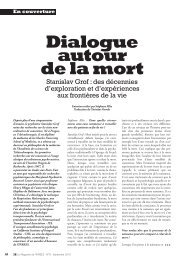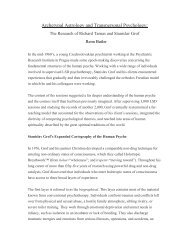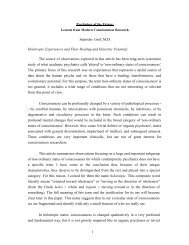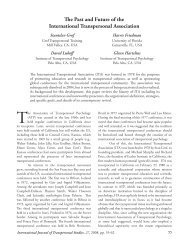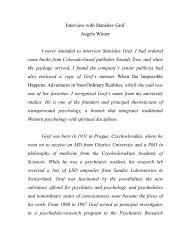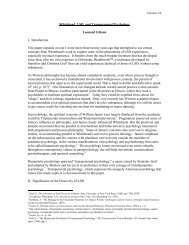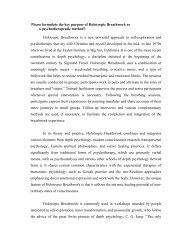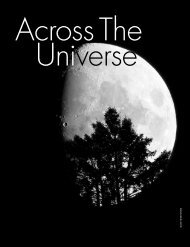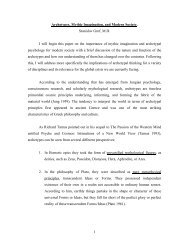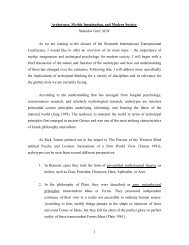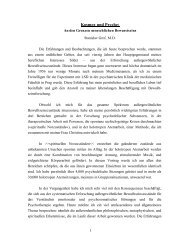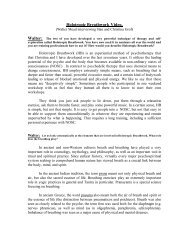1 PSYCHOSIS AND HUMAN SOCIETY: A Historical ... - Stanislav Grof
1 PSYCHOSIS AND HUMAN SOCIETY: A Historical ... - Stanislav Grof
1 PSYCHOSIS AND HUMAN SOCIETY: A Historical ... - Stanislav Grof
You also want an ePaper? Increase the reach of your titles
YUMPU automatically turns print PDFs into web optimized ePapers that Google loves.
<strong>PSYCHOSIS</strong> <strong>AND</strong> <strong>HUMAN</strong> <strong>SOCIETY</strong>:<br />
A <strong>Historical</strong> Perspective.<br />
<strong>Stanislav</strong> <strong>Grof</strong>, M.D.<br />
"The great progress that has been made in the realm of brain anatomy and pathological<br />
physiology and the general pre-possession in favor of natural science today have taught us to look,<br />
always and everywhere, for material causes, and to rest content once we have found them. The<br />
ancient metaphysical explanation of Nature was discredited on account of its manifold errors, so<br />
much so that the value of its psychological standpoint was lost."<br />
C. G. Jung: On the Problem of Psychogenesis in Mental<br />
Disease.<br />
"I got the kind of madness Socrates talked about, a divine release of the soul from the yoke of<br />
custom and convention. I refuse to be intimidated by reality anymore. After all, what is reality<br />
anyway? Nothing but a collective hunch."<br />
Lily Tomlin in The Search for Signs of Intelligent Life in the Universe by Jane<br />
Wagner.<br />
The concept of spiritual emergency is in conflict with the theoretical concepts and<br />
clinical strategies that dominate contemporary psychiatry. Strong dependence on the<br />
medical model and preference for biological explanations that characterize today’s<br />
psychiatric practices result in a tendency to treat emotional disorders, in general, and<br />
more serious ones, in particular, as diseases. The role of psychological factors is<br />
acknowledged in certain limited and clearly defined domains, such as neuroses,<br />
psychosomatic diseases, and the "placebo effect" - the often surprising therapeutic<br />
influence of pharmacologically inactive medication. Psychological explanations of<br />
psychoses are discussed in psychiatric handbooks, more or less as historical curiosities.<br />
In daily clinical practice of most psychiatrists, the medical model rules supreme; those<br />
who experiment with psychotherapeutic approaches in severe emotional disorders are<br />
rare exceptions. And the emphasis on the spiritual dimension of the human psyche, so<br />
crucial to the idea of spiritual emergency, is alien to mainstream psychiatric thinking. The<br />
current concepts and practices which dominate modern psychiatry, as well as their<br />
limitations and the controversies that surround them, can be fully understood only in light<br />
of the entire history of evolving views concerning unusual human experiences and<br />
behaviors. With this in mind, I would like to explore the approaches to severe mental<br />
disorders from a historical and cross-cultural perspective.<br />
1. The Dawn of Psychiatry:<br />
1
Metaphysics and Science In Ancient Cultures.<br />
References to psychiatric disorders including psychoses can be found in the world<br />
literature since antiquity. Vivid descriptions of various states belonging to this category<br />
exist in China, India, Mesopotamia, as well as in various cultures in the Mediterranean<br />
area. During these times, the prevailing opinion was that these conditions were caused by<br />
possession by evil spirits and demons or that they represented deserved divine<br />
punishment. The respective treatment was then either exorcism or appeal to the punishing<br />
deity combined with appropriate gifts and offerings. Therapy was executed primarily by<br />
the priests.<br />
While such a metaphysical understanding certainly prevailed in ancient cultures, it<br />
often coexisted with interpretations that can be seen as primitive precursors of scientific<br />
thinking. Also some of the treatment procedures and naturalistic remedies can be<br />
understood in scientific terms. Some of them have even served as direct inspiration for<br />
modern therapy, such as the rich pharmacopeias of antiquity.<br />
India.<br />
Among the descriptions of diseases found in the Atharvaveda, one of the ancient<br />
Hindu scriptures, are various forms of insanity. This Veda also contains the appeals to<br />
gods, prescriptions for the exorcism of demons, and outlines of the magical rites<br />
considered appropriate for various conditions. However, the Indian Brahmans also used<br />
exposure of the mentally ill persons to cobras with extracted teeth to dispel the psychotic<br />
condition through overwhelming fear. They staged for the same purpose faked attacks by<br />
elephants trained to stop in the last moment, or they surprised the mentally disturbed by a<br />
sudden fall into cold water. The therapeutic psychodrama arranged for important persons<br />
involved such complex ploys as arrest by the royal guard, sentence to death, and the<br />
king's "pardon" granted in the last minute.<br />
The efficacy of these procedures can easily be understood if one sees them as<br />
precursors of "shock therapies," that dominated modern psychiatry until the<br />
psychopharmacological revolution in the 1950s. They also make sense in view of the<br />
observations from experiential psychotherapies indicating that confrontation with death,<br />
in this case staged by one's own unconscious, has profound therapeutic effects. But the<br />
treatment strategies in ancient India were not limited to the above psychological means;<br />
2
they also included an amazing pharmacopeia. Of the many medicinal herbs, two deserve<br />
special attention. A plant with psychedelic properties, whose identity was lost in the<br />
course of time, received much attention in the Rigveda and was considered so powerful<br />
that it was given the name of a god, Soma. The Ayurvedic plant Rauwolfia serpentina<br />
used for treatment of insanity, one of the 500 herbs mentioned in the ancient Charaka<br />
Samhita, became the source of reserpine, an important prototype of modern tranquilizers.<br />
China.<br />
Similarly, in ancient China, the understanding of diseases, physical as well as<br />
mental, was based on the belief in gods and demons as the effective causes. Texts<br />
scratched on oracular bones from the Shang period (1766-1122 B.C.) petitioning gods for<br />
help give numerous examples indicating that refuge from suffering was sought in<br />
magic and exorcism. Clay figurines from the time of the Han dynasty that ruled China<br />
during the centuries around the birth of Christ represent shamans who were believed to<br />
posses power capable of combating mental disease.<br />
This tradition coexisted with naturalistic practices, which represented a unique and<br />
highly original blend of metaphysics and concrete pragmatically valid interventions. The<br />
origins of traditional Chinese medicine can be traced far back into history. The<br />
worldview and the way of thinking that characterizes this system of healing are very<br />
different from and incompatible with the philosophy of Western science. Its approach<br />
was holistic and emphasized disturbances of energy flow in the body underlying physical<br />
and mental problems, rather than pathology of individual organs. For this reason, Chinese<br />
medicine did not distinguish sharply between physical and mental diseases; they were<br />
considered to be different manifestations of the disturbed energetic equilibrium.<br />
The philosophy underlying traditional medicine in China saw the universe as a<br />
complex interplay of five elements or cosmic principles: fire, earth, metal, water, and<br />
wood. These governed various events in the macrocosm, as well as the functioning of the<br />
human body and mind. Elaborate maps were used depicting a system of meridians, or<br />
channels for the flow of chi, or subtle cosmic energy, through the body. In the last<br />
analysis, however, the elements and chi were just specific manifestations of one<br />
transcendent universal principle, the Tao, and its polar components, yin and yang.<br />
3
Beside an elaborate pharmacopeia, Chinese physicians used acupuncture -<br />
application of cold or hot needles to various points lying on the body meridians - to open<br />
the energy flow and reestablish dynamic equilibrium. The choice of the acupuncture<br />
points was not specific for diseases in the Western sense, but was based on the results of<br />
a diagnostic procedure assessing the overall energetic situation. However, there existed<br />
certain specific acupuncture points believed to reinstitute emotional equilibrium of<br />
severely disturbed patients. The pragmatic value of acupuncture has been confirmed in<br />
modern times, although the reasons for its efficacy remain incomprehensible from the<br />
Western scientific point of view.<br />
Egypt and Mesopotamia.<br />
The ancient Egyptians also believed that disease and insanity were the results of<br />
attacks by evil demons and spirits. The methods of healing used by priest - healers<br />
consisted in magical and religious rites aimed at expelling the malevolent entities that had<br />
caused the condition. Incantations, prayers, and sacrifice were the most important<br />
therapeutic tools of the time. An important institution in ancient Egypt were the<br />
procedures known as temple mysteries; most famous of these were the death - rebirth<br />
mysteries associated with the names of Isis and Osiris. Although their purpose was<br />
primarily spiritual transformation, their beneficial effects included also emotional and<br />
psychosomatic healing.<br />
Like India and China, Egypt had a rich pharmacopeia with many plants whose<br />
effects have been validated by modern science. Especially significant among them was<br />
poppy, which was used for opium - induced therapeutic sleep. It is interesting to mention<br />
in this context that treatment of depression by opium tincture belonged to popular<br />
practices of European psychiatry in the early decades of the twentieth century. The<br />
Mesopotamian cultures, Assyria and Babylonia, resembled Egypt in practicing a similar<br />
mixture of metaphysical and naturalistic healing.<br />
Greece and Rome.<br />
In ancient Greece, the cradle of Western civilization, the situation in regard to<br />
emotional disorders was particularly interesting and complex. Greek literature abounds in<br />
descriptions, both artistic and scientific, of various forms of insanity, and scenes<br />
representing mental derangement are depicted on ancient vases. Popular concepts of<br />
4
"madness" involved belief in supernatural causation, particularly possession by the dread<br />
goddesses Mania and Lyssa, sent by other angry deities. In addition, the goddess Artemis<br />
was said to inflict nervous and mental disorders and a similar role was also attributed to<br />
the underworld deities who were held responsible for madness, hysteria, epilepsy, and<br />
various neuroses. The gods frequently communicated with mortals through oracles,<br />
dreams, and visions. The treatment based on these beliefs was naturally prayer to the<br />
appropriate deity supported by gifts and offerings.<br />
The above situation is in sharp contrast with the fact that the same ancient Greece<br />
generated much knowledge of scientific relevance and is often referred to as the cradle<br />
of modern rational medicine and psychiatry. This concept is not quite accurate<br />
historically, since it ignores the fact that naturalistic medical practices had existed in<br />
many earlier ancient cultures and that Greece inherited much from Babylonia and Egypt,<br />
and even from India and China. However, it is indisputable that it was in Greece where<br />
the first systematic effort was made to formulate the principles of medical understanding<br />
of mental disorders.<br />
Already in the 5 th century B.C., the Greeks made the first attempts to develop an<br />
approach based on natural sciences which marked the beginning of biological psychiatry.<br />
At this time, the Pre-Socratic philosopher and physiologist Alcmaeon of Crotona<br />
conducted the first autopsies and concluded that the seat of reason and soul was the brain.<br />
In the 4 th century B.C., the famous Greek physician Hippocrates formulated a theory<br />
according to which the human body contained four basic fluids or "humors"- blood<br />
(sanguis), yellow bile (cholon), black bile (melancholon) and phlegma. He suggested that<br />
they played an important role in determining temperament and that imbalance among<br />
them was the cause of diseases including mental aberrations. Hippocrates also initiated<br />
therapeutic use of emetics, laxatives, and blood-letting (venepuncture), procedures that<br />
constituted main psychiatric treatment all through the Middle Ages. Two centuries later,<br />
another renowned physician, Asklepiades from Asia Minor, added to this triad<br />
hydrotherapy, diet, and physical exercises together with occupational and music therapy.<br />
The Greek genius also made valuable contributions to the psychological<br />
understanding of the mind and mental illness that have not lost their relevance even in<br />
modern times and are being rediscovered by contemporary psychology. The Greek<br />
understanding of dreams and work with them predated Freud by millennia and even<br />
included the use of free associations by Artemidoros of Daldianus. Plato's discussion of<br />
5
the four kinds of madness that he attributed to possession by deities (or in Jung's<br />
terminology archetypal beings) - ritual, poetic, erotic, and prophetic - are of great interest<br />
to modern students of psychoses.<br />
A special form of treatment which was very popular in ancient Greece was temple<br />
sleep or "incubation". After purification rites and abstinence from wine and food, the<br />
supplicant slept on the hide of the sacrificial animal in the portico of the healing temple<br />
near the image of the deity. In some instances, healing occurred through the direct<br />
intervention of the deity in the sleep, other times the suggestions for treatment came in<br />
the form of a dream. In modern times, temple incubation has attracted attention of the<br />
Jungian circles and its effects have been interpreted in terms of archetypal psychology.<br />
Another important institution were the mysteries of death and rebirth that existed in<br />
ancient Greece in many varieties, such as the Eleusinian mysteries, the mysteries of the<br />
Korybants, the Orphic cult, the Bacchanalia (or the rites of Dionysus), and the mysteries<br />
of Attis and Adonis. Like the Egyptian mysteries of Isis and Osiris, they were a<br />
combination of a spiritual procedure and a healing ceremony. Both Plato and Aristotle<br />
left positive testimonies about the therapeutic impact of the powerful and disorganizing<br />
experiences of the initiates in these mysteries. The healing and transformative potential<br />
of the ancient mysteries, as well as some of the psychological mechanisms involved have<br />
now become understandable in view of the findings of modern consciousness research<br />
and experiential psychotherapies.<br />
The Greek ideas continued to have considerable cultural influence in the ancient<br />
world during the centuries around the birth of Jesus, in spite of the fact that the political<br />
power was seized by the Roman Empire. Although some exceptional individuals, such as<br />
the physicians Celsus and Galenus or the politician - philosopher Cicero, made certain<br />
original contributions to the understanding of mental disorders, Roman popular and<br />
medical concepts of madness, as well as literary writings on the subject, were variations<br />
on the Greek themes.<br />
Two great physicians of the time, Aretaeus of Cappadocia and Soranus, laid the<br />
foundations for the treatment and management of mentally - ill based on humanitarian<br />
principles. They emphasized gentleness, tact, and discretion in the interaction with them<br />
and the need for contact and supervision during convalescence. The last contribution of<br />
the ancient world to psychology were the writings of St. Augustine, generally considered<br />
6
the greatest introspective mind before Freud. Although he was not specifically interested<br />
in mental disorders, his observations in this regard were of great importance. They<br />
included the recognition of the relevance of sexuality as a force influencing the human<br />
psyche and an early version of the concept of the unconscious.<br />
2. Heretics and Saints : Medieval Approaches to Psychoses.<br />
The fall of the western part of the Roman Empire in 476 A.D. signaled the<br />
beginning of a new historical era, the Middle Ages. During this period lasting almost<br />
1,000 years, there was very little progress in the exploration of the human mind in health<br />
and in disease. During this long time no major contributions were made in either the<br />
biological or the psychological understanding of psychoses. Among the few exceptions<br />
were the Christian philosopher Thomas Aquinas and theologian - scientist Albertus<br />
Magnus who described various psychotic symptoms and types of mental patients. The<br />
theory of psychopathology which they developed postulated that insanity was primarily a<br />
somatic disturbance; however, this was based on the theological assumption that the soul<br />
could not become sick.<br />
By and large, the medieval era represented a dark period in the history of humanity<br />
in general and psychiatry in particular. At the height of the Middle Ages, mental patients<br />
were locked in gloomy dungeons together with common criminals, condemned by society<br />
to jails or the unbelievably gruesome conditions of lunatic asylums. "Treatment"<br />
consisted of painful physical procedures, such as whipping, burning with hot iron, use of<br />
caustic ointments, immersion in cold water, placing ants under the clothes, exposure to<br />
sharp odors, and interference with sleep.<br />
Additional problems for people with various mental disorders were generated by<br />
the political and religious turmoil of the time. The period preceding the ultimate decline<br />
of feudalism gave rise to a number of heretic movements and to collective frenzy<br />
expressed in ecstatic dancing with frank sexual and aggressive elements. At the same<br />
time, the feudal idealization of woman carried by the troubadour tradition was rapidly<br />
disappearing. With the decay of medieval institutions woman began to emerge as a<br />
dangerous tempting and seductive being who, from the time of the original sin, had been<br />
possessed by the devil and whose ultimate goal was the destruction of man.<br />
7
The Church responded to this situation by a witch hunt of unprecedented<br />
proportions. In 1487, Pope Innocent VIII. issued a bull that officially accepted the<br />
belief in demons; it referred to men and women practicing witchcraft and causing<br />
sterility, impotence, disease, famine, and murder. Three years later, two Dominican<br />
monks Sprenger and Kramer, sent by the pope to Germany, wrote the book “Malleus<br />
Maleficarum” or "Witches' Hammer" that inseparably linked mental disorders and<br />
witchcraft for the centuries to come. This horrible document became the standard<br />
reference for Church and state alike in regard to the assessment of all unusual experiences<br />
and behaviors, as well as matters concerning the investigation, indictment, trial,<br />
judgment, and punishment of alleged witches.<br />
In the resulting atmosphere of collective metaphysical paranoia, large numbers of<br />
people with various forms of psychopathology and those who had what we would now<br />
call transpersonal experiences or spiritual emergency were accused of witchcraft or<br />
possession by the devil. They were exposed to unimaginable tortures by the Holy<br />
Inquisition that saw such drastic procedures as legitimate means to elicit confessions of<br />
liaison with the devil and to save the souls of witches and satanists from damnation<br />
and the horrors of hell. According to historical estimates, as a result of these trials,<br />
hundreds of thousands and possibly millions of people were killed, tortured to death<br />
during the investigations, hanged, or burned at the stake of the infamous autos-da-fe.<br />
These hideous witch trials continued until the eighteenth century in spite of occasional<br />
attempts of enlightened physicians, such as Paracelsus, Johannes Weyer, and Thomas<br />
Sydenham to replace these practices by medical considerations and procedures.<br />
In comparison with the countless unfortunates who ended up as victims of the<br />
Inquisition, there were a few who found a different fate; their unusual experiences were<br />
seen as being of divine origin and they became sanctified by the Christian Church. St.<br />
Teresa of Avila and St. John of the Cross can be mentioned as examples of this category.<br />
The arbitrary nature and capriciousness of the process that assigned people to the group<br />
of witches or saints can be exemplified by St. Joan of Arc. She was tried in 1431, found<br />
guilty of witchcraft and burnt at the stake, but twenty-five years after her death this<br />
judgment was annulled. Nearly five centuries later, in 1909, Joan was beatified and<br />
in1920 canonized by the Roman Catholic Church.<br />
During the medieval era, the Greek ideas continued to flourish in the Arabian<br />
countries and had a strong influence on their cultural life, resulting in a much more<br />
8
humane treatment of the mentally ill than Europe. Between the 9 th and 13 th centuries,<br />
many asylums were built in the Middle East where mental patients received humane and<br />
enlightened treatment. These facilities were located in charming gardens with fountains,<br />
featured a very relaxed atmosphere, and their therapeutic regimen included special diets,<br />
baths, drugs, fragrant oils and perfumes, as well as concerts of soothing music.<br />
3. Western Science and Psychoses: the Search for Diagnoses.<br />
As Western society was emerging from the Middle Ages and was leaving their sad<br />
legacy behind, the situation of the mentally ill started to change. The revolutionary and<br />
humanitarian trends that were spreading through the society found their way into the<br />
darkness of the insane asylums. This movement culminated in the work of Philip Pinel,<br />
who at the time of the French Revolution started to liberate mental patients, which in<br />
many instances literally meant removing manacles and chains from their bodies. At the<br />
same time, scientific interest began to replace religious fanaticism in the approach to<br />
mental disease.<br />
In the middle of the nineteenth century, there began to crystallize or the first time in<br />
history of medicine a keen interest in scientific classification of mental diseases. From<br />
the very beginning, these efforts involved a passionate controversy between two camps -<br />
one that wanted to differentiate these disorders according to symptoms and another that<br />
emphasized causes as the crucial criterion. The argument of those who advocated the<br />
division by presenting symptoms was clear: very few causes for emotional disorders were<br />
known and hypothetical assumptions about etiology simply were not a solid foundation<br />
for grouping of mental illness. Those who emphasized causes, on the other hand, insisted<br />
that in medicine a good classification must always be based on etiology. This second<br />
group had to make certain assumptions about the origins of mental illness and found itself<br />
immediately in the midst of another dilemma: Were all mental disorders due to organic<br />
diseases of the brain (or of some other part of the body indirectly influencing the brain)<br />
or was it possible that some of them were "functional", that is not related to biological<br />
damage, or even resulting from purely psychological causes?<br />
Let us first follow the history of the struggles for classification of psychoses by<br />
symptoms. Here the pioneering role was played by the German psychiatrist Emil<br />
Kraepelin, who is to this day considered the father of modern psychiatric classification.<br />
At a historical meeting of the South German Psychiatric Association that took place at the<br />
9
end of the nineteenth century in Heidelberg, Kraepelin presented his classification that<br />
distinguished two basic forms of psychoses, dementia praecox, literally premature<br />
dementia, ending eventually in mental deterioration, and manic - depressive psychosis<br />
which left the personality of the patient intact.<br />
Although Kraepelin's classification was generally accepted after initial opposition, it<br />
presented certain problems. Kraepelin himself admitted that many of his patients showing<br />
the symptoms of dementia praecox did not end in deterioration; they manifested what<br />
could be described as "dementia praecox sine dementia" (dementia praecox without<br />
dementia). It also became clear that the final outcome of the process was not a sound<br />
criterion for classification; the psychiatrist would have to wait for years for the final<br />
diagnosis. In addition, the emphasis on dementia created a very pessimistic and defeatist<br />
framework for treating psychotic patients.<br />
This unpleasant impasse was overcome by the Swiss psychiatrist Eugene Bleuler<br />
who in 1911 came up with a new name and a new conceptualization of the problem,<br />
influenced by reading Sigmund Freud's first book Studies in Hysteria. Bleuler's term<br />
"schizophrenia" replacing dementia praecox emphasized as the central feature functional<br />
characteristics rather than the final outcome of the process. He also suggested that<br />
schizophrenic symptoms could manifest both in the context of a disease or as a<br />
psychopathological reaction to various situations. Consequently, he expected some<br />
patients to deteriorate and others to recover with or without defect.<br />
In Bleuler's system, schizophrenia was subdivided into four types; three of these<br />
were identical with Kraepelin's forms of dementia praecox- hebephrenic, paranoid, and<br />
catatonic. Bleuler himself added the fourth type - simple schizophrenia. These four types<br />
shared certain common features and differed in their specific manifestations. Among<br />
Bleuler's fundamental contributions to psychiatry was the formulation of criteria for the<br />
diagnosis of schizophrenia and its differentiation from other psychoses. He pointed out<br />
that such manifestations as hallucinations, delusions, stupor, or negativism were not<br />
sufficient for the schizophrenic label; this required the presence of what Bleuler<br />
considered to be "primary symptoms".<br />
The first of these was a specific and characteristic disorder of the thought processes<br />
manifesting in unusual associations. Another critical feature was incongruence between<br />
the content of thoughts and the accompanying emotions, resulting in inappropriate<br />
10
eactions to situations. Bleuler talked here about dissociation between thought and affect.<br />
Among the primary schizophrenic symptoms was also withdrawal into the fantasy world<br />
and autism. And the last of these was strong emotional ambivalence leading to<br />
conflicting impulses and indecision. Bleuler's definition of schizophrenia and his<br />
classification system have survived with minor modifications until the present day.<br />
Modern psychiatry divides psychotic reactions into two large categories. In the first<br />
of these are organic psychoses - conditions caused by physical changes in the brain or in<br />
the body that can be detected by the existing clinical and laboratory techniques. Typical<br />
examples of this category would be psychological changes accompanying degenerative<br />
processes, cardiovascular disorders, infections, intoxications, and traumatic afflictions of<br />
the brain, typhoid fever or uremia. These belong unquestionably into the domain of<br />
medicine and are of little relevance for the problem of spiritual emergency. What<br />
interests us in this context is the second category of reactions, referred to as functional<br />
psychoses; these lack any known specific organic basis detectable by today's laboratory<br />
methods.<br />
Here belong above all schizophrenic reactions of all four types described above<br />
(schizophrenia simplex, hebephrenica, paranoides, and catatonica) and a mixed form<br />
called undifferentiated schizophrenia. Simple schizophrenia is characterized by a gradual<br />
loss of interests, ambitions, and initiative. As the personality slowly disintegrates, the<br />
person shows neglect for appearance, hygiene, and basic duties; there is a strong<br />
tendency toward withdrawal and social isolation. Hebephrenic schizophrenia involves a<br />
marked regression to primitive, disorganized, and uninhibited behavior that can look like<br />
a caricature of manners observed during puberty, such as grinning, grimacing and<br />
inappropriate outbursts of laughter. Paranoid schizophrenia usually shows less<br />
regression, has greater ego resources, and is socially better established. Patients with this<br />
form of psychosis can have hallucinations and delusions of persecution and grandeur.<br />
Their general attitude is suspicious and often aggressive. Their intellect typically remains<br />
surprisingly intact outside of the area of delusions. And finally catatonic schizophrenia<br />
has as its most characteristic feature extreme changes in motor behavior which can range<br />
from complete inactivity and stupor to severe agitation. Catatonics can also show various<br />
bizarre forms of behavior; they repeat sentences they hear from other people (echolalia),<br />
imitate in a mirror-like fashion their movements and gestures (echopraxia), or maintain<br />
for many hours various unnatural postures (flexibilitas cerea, waxy flexibility). They<br />
might not respond to ordinary speech, but react to whispering or to orders given in a<br />
11
military tone. In the past, patients of this kind contributed to the grotesque atmosphere of<br />
locked wards of psychiatric hospitals. Undifferentiated schizophrenia shows symptoms of<br />
several of the "pure" types and cannot be clearly assigned to any of them.<br />
Another group of functional psychoses is the manic-depressive variety,<br />
characterized primarily by dramatic emotional changes. Depressive phases of such<br />
reactions involve deep sadness, difficult and slow thinking, and general inhibition of<br />
activity. The manic phases represent the polar opposite in that they are euphoric, with<br />
accelerated thinking and talking, and an uncontrollable drive for action. The official<br />
classification distinguishes also paranoid reactions which differ from schizophrenia. The<br />
most important characteristics of these conditions are intact personality, as well as<br />
emotions and behavior that are consistent with the nature and content of the delusional<br />
ideas. These delusions are usually persecutory, grandiose, jealous, or erotic.<br />
4. Medicine Versus Psychology: Dispute<br />
About the Causes and Treatment of Psychoses.<br />
The attempts at understanding the causes of psychotic states and finding appropriate<br />
treatments have divided professionals into two groups with fundamental differences of<br />
opinion. Toward the end of the nineteenth century and in the first decades of this one, a<br />
passionate controversy developed between those who believed that all major mental<br />
disorders were due to physical diseases of the brain, or various organs of the body, and<br />
others who saw them as results of a dynamic psychological struggle or some kind of<br />
serious conflict. This debate between the biological and psychological orientation in<br />
psychiatry and the nature/nurture controversy has continued until the present day.<br />
In the course of its history, psychiatry has become a subspecialty of medicine. For<br />
all practical purposes, the biological orientation has dominated the field. Mainstream<br />
conceptual thinking in psychiatry, the approach to individuals with emotional disorders<br />
and behavior problems, the strategies and financing of research, and basic education and<br />
training are all dominated by the medical model. This situation is a consequence of two<br />
important historical developments. Medicine has been successful in establishing the<br />
cause and finding effective therapy for a relatively small group of mental abnormalities<br />
which have a clearly organic basis. In addition, it has demonstrated its ability to control<br />
symptomatically many of those disorders for which specific etiology and therefore causal<br />
treatment could not be found.<br />
12
The Cartesian-Newtonian thinking dominating Western science that proved to be<br />
extremely effective in physics and had a powerful influence on all the other disciplines,<br />
played a critical role in the development of neuropsychiatry and psychology. The<br />
renaissance of interest in mental disorders in the nineteenth century firmly established<br />
psychiatry as a medical discipline. Rapid advances in anatomy, physiology, pathology,<br />
chemistry, and microbiology resulted in a determined search for organic causes of all<br />
mental disorders in the form of infections, metabolic disturbances, vascular changes, or<br />
degenerative processes in the brain and elsewhere in the body.<br />
This biological orientation in psychiatry was inspired by the discovery of the<br />
causes of several mental disorders that led to effective therapeutic measures. A prime<br />
example of this was general paresis, a condition associated among others with delusions<br />
of grandeur and serious disturbances of memory and intellect. Here the discovery that this<br />
disease was the result of tertiary syphilis of the brain, a disease caused by the protozoon<br />
Spirochete pallidum, was followed by successful treatment combining artificially induced<br />
fever (pyretotherapy) and administration of preparations containing arsenic and mercury.<br />
Similarly, once it became clear that mental disturbances associated with skin problems<br />
and gastrointestinal symptoms (pellagra) were due to deficiency of a certain vitamin of<br />
the B group (vitamin B6 or pyridoxin), it became possible to correct them by an adequate<br />
supply of the missing vitamin. Some other types of mental dysfunctions could be linked<br />
to encephalitis or meningitis, arteriosclerosis, various forms of malnutrition, degenerative<br />
changes in the brain, and cerebral tumors.<br />
These initial successes spurred enthusiastic search for biological causes of other<br />
mental disorders, particularly psychoses. The scientists pursuing this avenue of research<br />
were convinced that psychotic states represented such a drastic distortion of "objective<br />
reality" that one had to assume some serious damage to the organs involved in the<br />
perception and testing of reality, particularly the central nervous system. This conviction<br />
was the moving force behind countless studies looking for specific causes of psychoses,<br />
such as genetic factors, constitutional dispositions, anatomical and neuropathological<br />
anomalies, endocrine disturbances, autoimmune reactions, viral and bacterial infections,<br />
and biochemical deviations.<br />
Many hypotheses have been formulated and tested over the years, but the results<br />
have been generally inconclusive and disappointing. Except the increased incidence of<br />
13
psychoses among the relatives of psychotic patients, which is a fact open to various<br />
interpretations, no findings have been sufficiently constant to provide adequate<br />
etiological clues. The successes of unraveling the causes of serious mental disorders have<br />
been isolated and limited to a very small fraction of the problems that psychiatry deals<br />
with. The causes of the majority of psychotic episodes continues to be a mystery. With<br />
the privilege of hindsight, we can say that it was somewhat premature to commit<br />
psychiatry so exclusively to the medical model, particularly since this development has<br />
not been without serious problems.<br />
The failure of the biological approaches to demonstrate the organic nature of most<br />
psychotic states and of many other emotional and psychosomatic disorders encouraged<br />
the development of psychological schools of psychiatry. These have been exploring the<br />
possibility that the origin of such disturbances might be in the patients' life history and in<br />
various emotional traumas and conflicts. For all practical purposes, this avenue of<br />
research began with the epochal discoveries of Sigmund Freud and his disciples. Freud<br />
him-self made the first major attempt at psychological understanding of psychoses in his<br />
famous analysis of the autobiographical diary of judge Schreber who had suffered from<br />
paranoia.<br />
Freud's followers, such as Karl Abraham, Victor Tausk, Melanie Klein, and others<br />
developed systematically Freud's original idea that psychotic experiences represent a<br />
regression into early infancy and emergence of repressed traumatic memories and<br />
conflicts from that time. In addition to psychoanalytic theories, that interpret the<br />
problems of psychotics in terms of conflicts within the psyche, there have been others<br />
emphasizing the role of the interpersonal relationship with the mother and other family<br />
members in the genesis of mental disorders. The extensive studies on "schizophrenogenic<br />
mothers" and Harry Stack Sullivan's interpersonal theory can be mentioned here as<br />
salient examples.<br />
Considerable attention was also paid to the overall climate in the family. In this<br />
context, the entire family system was seen as pathological and the psychotic was just the<br />
"identified patient" (IP), the person in whom the problems found the most dramatic<br />
expression. This approach was particularly characteristic for the research group at the<br />
Mental Research Institute (MRI) in Palo Alto, California, headed by generalist Gregory<br />
Bateson, author of the famous "double bind" theory of schizophrenia. Ruth and Theodore<br />
Lidz at Yale University conducted a meticulous in-depth study of all the members of<br />
14
sixteen families of schizophrenic patients. These attempts at psychological understanding<br />
of psychoses also led to the development of important psychological alternatives to<br />
biological therapies that ranged from psychotherapy with individual patients to<br />
systematic work with their parents and entire families. Frieda Fromm-Reichmann, Renée<br />
Sechehay, John Rosen, and Jacob Moreno deserve special notice in this regard.<br />
The psychological approaches to psychoses, however fascinating, did not have<br />
significant impact on mainstream psychiatry. As long as their interpretations remained<br />
limited to postnatal biography, they were not really convincing. The depth and intensity<br />
of the emotions observed in psychotic states, such as anxiety of cosmic proportions,<br />
murderous aggression, violent self-destructive impulses, or abysmal guilt, seemed too<br />
enormous to reflect the distress of a hungry or lonely infant. An even more serious<br />
problem was the abundance of fantastic themes in the experiences of psychotic patients.<br />
Among these were scenes of destruction of the world and its recreation, visions of hells,<br />
heavens and divine lights of supernatural beauty, encounters with deities and demons,<br />
and complex sequences staged in other times and countries, or even extraterrestrial<br />
settings. It would require a big stretch of imagination to assume that these were products<br />
originating in the infantile psyche.<br />
One of the early pioneers of psychoanalysis, Freud's disciple and renegade Otto<br />
Rank, formulated a psychological theory that - unlike the speculations of his teacher and<br />
his colleagues - could account for the extraordinary intensity of psychotic emotions.<br />
According to him, the psychological history of the individual did not start after birth, but<br />
included prenatal existence and the traumatic experience of birth itself. Although Rank<br />
himself put more emphasis on the loss of the security of the womb than on the emotional<br />
and physical trauma associated with the passage through the birth canal, biological birth<br />
is - at least potentially - a life-threatening event. It could thus be a likely source of<br />
immensely intense emotions.<br />
Rank's theory, however plausible, had little influence on academic circles, since it<br />
challenges the traditional medical belief that --because of the unfinished myelinization of<br />
the neurons in the neocortex-- the brain of the newborn is not sufficiently mature to be<br />
able to record and retain memories of this event. In the last two decades, prenatal and<br />
perinatal research dispelled this objection and experiential therapies brought powerful<br />
support for Rank's ideas. However, even Rank's system could not give convincing<br />
explanation for the rich, complex, and extraordinary content of psychotic experiences and<br />
15
for the fact that they have often a strong mystical emphasis. This task had to wait for<br />
transpersonal psychology, particularly the work of Carl Gustav Jung.<br />
5. Re-Visioning of Psychiatry :<br />
Transpersonal Understanding of Psychoses.<br />
Transpersonal psychology as such did not come into being as a separate discipline<br />
until the late 1960s; however, important developments within psychology that had all the<br />
essential characteristics of a transpersonal approach had preceded it by many decades.<br />
The most influential early pioneer of this movement was Carl Gustav Jung. His prolific<br />
writings provided the conceptual framework necessary for understanding some of the<br />
most puzzling aspects of non-ordinary states of consciousness. The cornerstones of his<br />
theory - the concept of the collective unconscious, discovery of its primordial organizing<br />
patterns or archetypes, and recognition of the mythological nature of the human psyche -<br />
represent a solid foundation for a comprehensive approach to mystical as well as<br />
psychotic phenomena.<br />
Jung's interest in the area of spiritual crises and psychoses was not purely academic.<br />
As he so vividly described in his autobiography Memories, Dreams, Reflections, he had<br />
struggled in the course of his long life with many dramatic and challenging spontaneous<br />
experiences. Of particular interest was an episode that involved perception of and<br />
communication with spirits shared by other members of Jung's family. During this time,<br />
Jung wrote what is probably his most remarkable work, Septem Sermones ad Mortuos<br />
(Seven Sermons to the Dead), a channeled text signed by the Gnostic philosopher<br />
Basilides from ancient Alexandria. Jung is a fine example of how a gifted and creative<br />
individual can use difficult trans-personal experiences - a spiritual emergency - for his<br />
personal growth and for great benefit of others.<br />
Jung's contemporary, Italian psychiatrist and psychoanalyst Roberto Assagioli,<br />
developed independently an original system of transpersonal theory and therapy called<br />
psychosynthesis. Like Jung, he recognized the existence of the collective unconscious and<br />
appreciated the role of spirituality in human life. It is very significant in regard to the<br />
concept of spiritual emergency that Assagioli was well aware of the fact that many states<br />
diagnosed and treated as mental diseases are actually crises of spiritual awakening. He<br />
addressed this problem in his essay entitled Self-Realization and Psychological<br />
16
Disturbances, in which he discussed the difficulties that often precede, accompany, and<br />
follow a powerful spiritual opening.<br />
Another important contribution to transpersonal understanding of non-ordinary<br />
states came from the work of the famous American psychologist Abraham Maslow.<br />
Maslow conducted a large study of people who had had spontaneous mystical states, or<br />
"peak experiences" as he called them. Maslow's research showed that traditional<br />
psychiatry was in error diagnosing such conditions as mental diseases and treating them<br />
with routine suppressive medication. According to him, peak experiences often occur in<br />
otherwise healthy individuals and when they are allowed to complete themselves they are<br />
conducive to "self-actualization" or "self-realization" - a fuller development of one's<br />
potential. The work of Jung, Assagioli, and Maslow has attracted many dedicated<br />
followers and received high esteem in transpersonal circles, but has remained on the<br />
periphery of academic psychology and psychiatry.<br />
Although comprehensive in itself and in accord with the entire cultural history of<br />
humanity, transpersonal psychology meets strong resistance among traditionally educated<br />
scientists. Its wider acceptance will have to wait until the time when the revolutinary<br />
developments in modern science replace the Newtonian - Cartesian thinking with which<br />
transpersonal psychology is in principle incompatible. It is very exciting and encouraging<br />
to see the emergence of many revolutionary advances of modern science that have been<br />
referred to as the "new paradigm" (quantum-relativistic physics, information and systems<br />
theory, the holographic model of the brain and the universe, the theory of morphogenetic<br />
fields, and many others). While they seriously question and undermine the most<br />
fundamental assumptions of seventeenth century thinking that still dominates mainstream<br />
science, they are all compatible with the transpersonal perspective.<br />
VI. Existentialism and Antipsychiatry:<br />
Radical Challenges to the Medical Model.<br />
Having reviewed the history of opinions about unusual experiences and<br />
behaviors, we should at least briefly mention certain developments that challenge the<br />
basic foundations of psychiatry by denying the very concept of psychopathology. Thus<br />
phenomenology, based on the work of the German philosopher Edmund Husserl and<br />
represented by such names as Ludwig Binswanger and Medard Boss, altogether refuses<br />
the disease concept of psychiatry. According to this view, insanity is nothing more than<br />
17
exaggeration of the individual's habitual character, psychosis is simply a different way of<br />
being in the world, of Dasein. The patient exists in a reality of his or her own which<br />
cannot be fully shared by people who are oriented to "common sense" standards and<br />
values.<br />
Thomas Szasz, an outspoken critic of the disease concept of emotional disorders,<br />
goes even further. In his controversial book, The Myth of Mental Illness, he denies<br />
psychiatry the right to assign pathological labels to people who have unusual experiences<br />
and behaviors and treat them as patients. He suggests that psychiatry in assuming the<br />
right to judge the appropriateness of human experience and to drastically limit people's<br />
freedom and modifying their behavior acts essentially like the medieval Inquisition.<br />
The dynamic and radical Scottish psychiatrist R.D. Laing believed that the situation<br />
in regard to psychotic patients is severely distorted. According to him, it is actually<br />
modern human society that is dangerously insane and the psychotics, finding its values<br />
unbearable and unacceptable, withdraw into the inner world of fantasy. Laing was<br />
strongly opposed to psychiatric interventions of any kind and preferred that the process<br />
take its natural course. He believed that in the current state of the art psychotics have<br />
more to teach their psychiatrists than the doctors have to offer their patients.<br />
The extreme expression of the above trends is the movement of antipsychiatry,<br />
founded by the rebel British psychotherapist of South African origin, David Cooper.<br />
Cooper, who had personally experienced in his life profound spiritual and bodily crises<br />
that took the form of death and rebirth, came to question the value of psychiatric<br />
interventions altogether. The choice of the name "antipsychiatry" is unfortunate, since it<br />
directs more energy into disqualifying traditional psychiatry than into suggesting and<br />
developing better alternatives. Cooper's philosophy has become the ideological basis for<br />
various movements of former psychiatric patients who feel bitterness about the way the<br />
current system has treated them and seek various forms and degrees of retribution.<br />
Conclusions from the Review of the History of Psychoses.<br />
After this brief excursion into history, we can now summarize the present situation<br />
in psychiatry concerning the so called functional psychoses. Despite enormous<br />
investment of time, energy, and money, the problems related to the nature and origin of<br />
18
these conditions have successfully resisted combined efforts of scientists from many<br />
different disciplines for many decades. The theories of psychosis cover an extremely<br />
wide range from strictly organic to purely psychological and even philosophical. Within<br />
both the biological and depth-psychological camp, there exists an enormous plethora of<br />
theories and therapeutic approaches.<br />
If anything characterizes the overall situation, it is an amazing variety of opinions<br />
and lack of agreement on the most fundamental issues. In view of this situation, adding<br />
yet another perspective on psychosis - the concept of spiritual emergency - to the plethora<br />
of those that exist already does not violate any sacrosanct knowledge that has been<br />
proven beyond any reasonable doubt and is generally accepted. The highly rewarding<br />
results of this new approach to the understanding and treatment of non-ordinary states of<br />
consciousness more than justifies this effort.<br />
19




